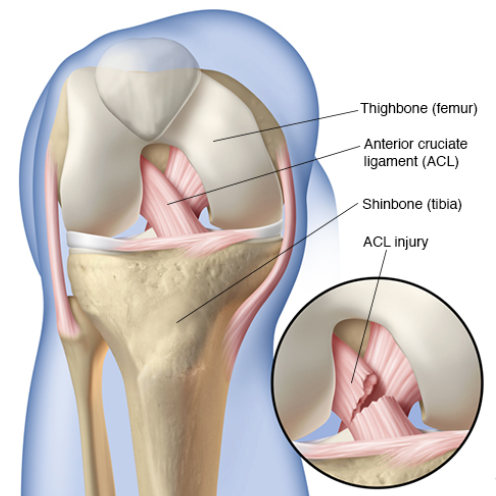Road to Recovery: ACL Injury and Surgery, Part 1

So you are going in for ACL surgery due to an injury or excessive strain?
On behalf of the HealFast team, we are sorry to hear this and wish you the best! We hope you have a swift surgical recovery and can get back on your feet in no time. As part of your upcoming surgery, there are some things you should know and prepare for ahead of time.
For this particular post, we wanted to focus on preparations for surgery specifically for the ACL. While not all ACL surgeries are the same, we will try our best here to provide a general outline of what to expect and then dive into the injury itself.
What is the ACL?
The ACL is a system of ligaments (ligaments attach bone to bone) that hold the knee joint together and provide stability over its wide range of movements. There are 2 collateral ligaments that help provide stability on the sides of the knee and 2 cruciate ligaments that provide a front-to-back and rotatory function.
The Anterior Cruciate Ligament, (“ACL”) is one of two ligaments in the center of the knee, attaching the femur (thigh bone) and the tibia (shin bone). The ACL is tasked with holding these bones in proper position and alignment as the knee is used. While the ACL is always important, you can imagine that for activities involving lots of rotation, changes in direction, and torque this is particularly important.

Source 1: Mayo Clinic Website.
What is a “typical” ACL Injury?
In general, an ACL injury is most commonly called a “tear” in the ligament. This can be a full tear or a partial tear, but depending on the severity, surgical intervention may be required. As a ligament injury, the tear could be at the connective portions on/near the bones or in the middle. Because the ACL is on the “inside” of the knee it is harder to determine the full extent without MRI or X-ray, and in the worst cases, an arthroscopic examination might be required to get a full assessment.
Lastly, sometimes other associated injuries can occur during the initial injury. Sometimes these are not even detected until surgery and thus might need to be corrected during the operation. This can of course add to the physical injury and post-surgery recovery time. Your surgeon will know best and handle as needed during the operation.
But how are ACL injuries caused?
As previously alluded to, the degree of stress on the knee joint is the usual culprit especially when involving twisting or hyperextension. These types of injuries can occur from falling, slipping, an accident, or intense sports. The more intense a sport is on the knees (such as football, skiing, basketball, or volleyball) the more likely an injury can occur. Even direct blows to the outside of the knee (as shown below) in contact sports can put you at risk for an ACL injury.

Source 3
Do I have an ACL injury? What are the symptoms of ACL Injury?
Firstly, the immediate symptoms of an ACL injury can be a pain, swelling, stiffness, limping, and instability in the knee. This will make it difficult to walk and unfortunately, a significant ACL injury won’t be able to repair itself without surgical intervention. Even bracing and physical therapy can only do so much to bring the individual up to a functioning or pre-injury level.
If medical assistance is not sought, continued instability might overstress other ligaments and workings of the knee joint to cause additional problems. For example, damage to the meniscus (the knee’s shock absorber) can lead to further pain and limitation of movement. As we age, this can even lead to osteoarthritis.
So what do I do?
It is imperative that if you are experiencing the symptoms mentioned above after intense exercise, sporting activities, a fall or accident, while potentially hearing a nasty pop of the knee; that you seek medical counsel.
Alongside rest, icing, and healthy injury and surgery nutrition programs, surgical intervention might be necessary. Check out our “Pathway to Recovery: ACL Injury and Surgery, Part 2” for more information on how an ACL reconstruction is generally performed and what pre-surgery preparation and nutrition you can follow to ensure a smoother recovery.
We hope you enjoyed the first part of this ACL Injury overview. As always be safe, stay informed, and be healthy! If you would like to read other articles on surgery preparation and nutrition, check out our more general post: Surgery and Injury Recovery: Nutrition for a Strong Recovery.
Check out Part 2 of this article, and be sure to follow us on Facebook and Twitter! As always be safe, stay informed, and be healthy!
Citations:
-
Image: Mayo Clinic Website.
-
Image: http://www.wikihow.com/Slide-Tackle-in-Soccer#/Image:Slide-Tackle-in-Soccer-Step-6.jpg
General Disclaimer: All information here is for educational purposes only and is not meant to cure, heal, diagnose nor treat. This information must not be used as a replacement for medical advice, nor can the writer take any responsibility for anyone using the information instead of consulting a healthcare professional. All serious disease needs a physician.







